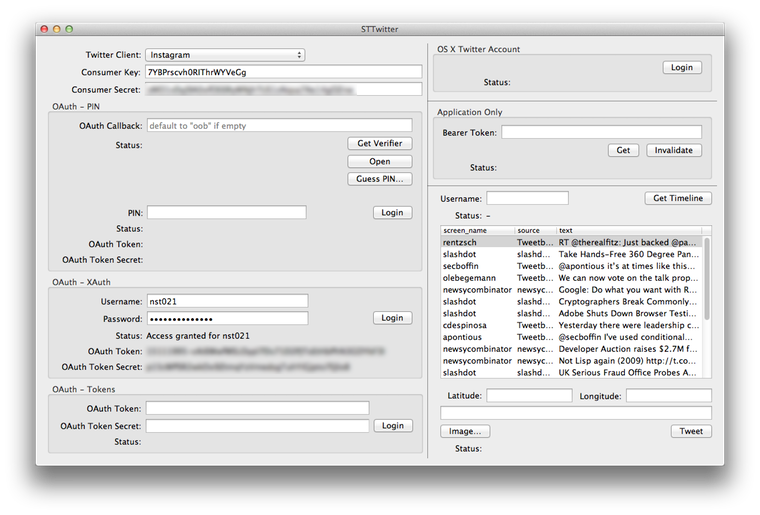A comprehensive Objective-C library for Twitter REST API 1.1
STTwitter will be presented at SoftShake 2013, Geneva, on October 24th.
- Installation
- Code Snippets
- Various Kinds of OAuth Connections
- OAuth Consumer Tokens
- Demo / Test Project
- Integration Tips
- Troubleshooting
- Developers
- Applications Using STTwitter
- BSD 3-Clause License
Drag and drop STTwitter directory into your project.
Link your project with the following frameworks:
- Accounts.framework
- Twitter.framework
- Security.framework (OS X only)
- Social.framework (iOS only, weak)
If you want to use CocoaPods, include the STTwitter pod in your project's podfile and install it:
pod 'STTwitter'
pod install
STTwitter does not depend on AppKit or UIKit and can be used in a command-line Twitter client.
STTwitter requires iOS 5+ or OS X 10.7+.
Notes:
- STTwitter must be used from the main thread
- all callbacks are called on the main thread
STTwitterAPI *twitter = [STTwitterAPI twitterAPIWithOAuthConsumerName:@""
consumerKey:@""
consumerSecret:@""
username:@""
password:@""];
[twitter verifyCredentialsWithSuccessBlock:^(NSString *username) {
// ...
} errorBlock:^(NSError *error) {
// ...
}];
[twitter getHomeTimelineSinceID:nil
count:100
successBlock:^(NSArray *statuses) {
// ...
} errorBlock:^(NSError *error) {
// ...
}];
[twitter getStatusesSampleDelimited:nil
stallWarnings:nil
progressBlock:^(id response) {
// ...
} stallWarningBlock:nil
errorBlock:^(NSError *error) {
// ...
}];
STTwitterAPI *twitter = [STTwitterAPI twitterAPIAppOnlyWithConsumerKey:@""
consumerSecret:@""];
[twitter verifyCredentialsWithSuccessBlock:^(NSString *bearerToken) {
[twitter getUserTimelineWithScreenName:@"barackobama"
successBlock:^(NSArray *statuses) {
// ...
} errorBlock:^(NSError *error) {
// ...
}];
} errorBlock:^(NSError *error) {
// ...
}];
You can instantiate STTwitterAPI in three ways:
- use the Twitter account set in OS X Preferences or iOS Settings
- use a custom
consumer keyandconsumer secret(three flavors)- get an URL, fetch a PIN, enter it in your app, get oauth access tokens
- set
usernameandpassword, get oauth access tokens with XAuth, if the app is entitled to - set
oauth tokenandoauth token secretdirectly
- use the Application Only authentication and get / use a "bearer token"
So there are five cases altogether, hence these five methods:
+ (STTwitterAPI *)twitterAPIOSWithFirstAccount;
+ (STTwitterAPI *)twitterAPIWithOAuthConsumerKey:(NSString *)consumerKey
consumerSecret:(NSString *)consumerSecret;
+ (STTwitterAPI *)twitterAPIWithOAuthConsumerKey:(NSString *)consumerKey
consumerSecret:(NSString *)consumerSecret
username:(NSString *)username
password:(NSString *)password;
+ (STTwitterAPI *)twitterAPIWithOAuthConsumerKey:(NSString *)consumerKey
consumerSecret:(NSString *)consumerSecret
oauthToken:(NSString *)oauthToken
oauthTokenSecret:(NSString *)oauthTokenSecret;
+ (STTwitterAPI *)twitterAPIAppOnlyWithConsumerKey:(NSString *)consumerKey
consumerSecret:(NSString *)consumerSecret;
Reference: https://dev.twitter.com/docs/ios/using-reverse-auth
The most common use case of reverse authentication is letting users register/login to a remote service with their OS X or iOS Twitter account.
iOS/OSX Twitter Server
--------------> reverse auth.
< - - - - - - - access tokens
-----------------------------> access tokens
<-------------- access Twitter on user's behalf
- - - - - - ->
Here is how to use reverse authentication with STTwitter:
STTwitterAPI *twitter = [STTwitterAPI twitterAPIWithOAuthConsumerName:nil
consumerKey:@"CONSUMER_KEY"
consumerSecret:@"CONSUMER_SECRET"];
[twitter postReverseOAuthTokenRequest:^(NSString *authenticationHeader) {
STTwitterAPI *twitterAPIOS = [STTwitterAPI twitterAPIOSWithFirstAccount];
[twitterAPIOS verifyCredentialsWithSuccessBlock:^(NSString *username) {
[twitterAPIOS postReverseAuthAccessTokenWithAuthenticationHeader:authenticationHeader
successBlock:^(NSString *oAuthToken,
NSString *oAuthTokenSecret,
NSString *userID,
NSString *screenName) {
// use the tokens...
} errorBlock:^(NSError *error) {
// ...
}];
} errorBlock:^(NSError *error) {
// ...
}];
} errorBlock:^(NSError *error) {
// ...
}];
Contrary to what can be read here and there, you can perfectly access direct messages from iOS Twitter accounts.
In Twitter REST API v1.1, each client application must authenticate itself with consumer key and consumer secret tokens. You can request consumer tokens for your app on Twitter website: https://dev.twitter.com/apps.
STTwitter demo project comes with TwitterClients.plist where you can enter your own consumer tokens.
There is a demo project for OS X in demo_osx, which lets you choose how to get the OAuth tokens (see below).
Once you got the OAuth tokens, you can get your timeline and post a new status.
There is also a simple iOS demo project in demo_ios.
There are a lot of optional parameters In Twitter API. In STTwitter, you can ignore such parameters by passing nil. Regarding boolean parameters, STTwitter can't just use Objective-C YES and NO because NO has the same value as nil (zero). So boolean parameters are wrapped into NSNumber objects, which are pretty easy to use with boolean values thanks to Objective-C literals. So, with STTwitter, you will give an optional parameter of Twitter API either @(YES), @(NO) or nil.
STTwitter provides a full, "one-to-one" Objective-C front-end to Twitter REST API. It often results in long methd names with many parameters. In your application, you may want to add your own simplified methods on top of STTwitterAPI. A good idea is to create an Objective-C category for your application, such as shown in the following code.
STTwitterAPI+MyApp.h
#import "STTwitterAPI.h"
@interface STTwitterAPI (MyApp)
- (void)getStatusesShowID:(NSString *)statusID
successBlock:(void(^)(NSDictionary *status))successBlock
errorBlock:(void(^)(NSError *error))errorBlock;
@end
STTwitterAPI+MyApp.m
#import "STTwitterAPI+MyApp.h"
@implementation STTwitterAPI (MyApp)
- (void)getStatusesShowID:(NSString *)statusID
successBlock:(void(^)(NSDictionary *status))successBlock
errorBlock:(void(^)(NSError *error))errorBlock {
[self getStatusesShowID:statusID
trimUser:@(YES)
includeMyRetweet:nil
includeEntities:@(NO)
successBlock:^(NSDictionary *status) {
successBlock(status);
} errorBlock:^(NSError *error) {
errorBlock(error);
}];
}
@end
Twitter restricts the xAuth authentication process to xAuth-enabled consumer tokens only. So if you get an error like NSURLErrorDomain Code=-1012, Unhandled authentication challenge type - NSURLAuthenticationMethodOAuth2 while accessing https://api.twitter.com/oauth/access_token then your consumer tokens are probably not xAuth-enabled. You can read more on this on Twitter website https://dev.twitter.com/docs/oauth/xauth and ask Twitter to enable the xAuth authentication process for your consumer tokens.
STTwitter is supposed to be used from main thread. The network requests are performed anychronously and the callbacks are guaranteed to be called on main thread.
Please fill an issue on GitHub.
The application only interacts with STTwitterAPI.
STTwitterAPI maps Objective-C methods with all documented Twitter API endpoints.
You can create your own convenience methods with fewer parameters. You can also use this generic methods directly:
- (NSString *)fetchResource:(NSString *)resource
HTTPMethod:(NSString *)HTTPMethod
baseURLString:(NSString *)baseURLString
parameters:(NSDictionary *)params
progressBlock:(void (^)(NSString *requestID, id response))progressBlock
successBlock:(void (^)(NSString *requestID, NSDictionary *rateLimits, id))successBlock
errorBlock:(void (^)(NSString *requestID, NSError *error))errorBlock;
+-------------------------------------------------+
| Your Application |
+-------------------------------------------------+
v
+-------------------------------------------------+
| STTwitterAPI |
+-------------------------------------------------+
v v v
+ - - - - - - - - - - - - - - - - - - - - - - - - +
| STTwitterOAuthProtocol |
+ - - - - - - - - - - - - - - - - - - - - - - - - +
v v v
+-------------+----------------+------------------+
| STTwitterOS | STTwitterOAuth | STTwitterAppOnly |
| +----------------+------------------+
| | STHTTPRequest |
+-------------+-----------------------------------+
|
+ Accounts.framework
+ Social.framework
* STTwitterAPI
- can be instantiated with the authentication mode you want
- provides methods to interact with each Twitter API endpoint
* STTwitterOAuthProtocol
- provides generic methods to POST and GET resources on Twitter hosts
* STTwitterOS
- uses Twitter accounts defined in OS X Preferences or iOS Settings
- uses OS X / iOS frameworks to interact with Twitter API
* STTwitterOAuth
- implements OAuth and xAuth authentication
* STTwitterAppOnly
- implements the 'app only' authentication
- https://dev.twitter.com/docs/auth/application-only-auth
* STHTTPRequest
- block-based wrapper around NSURLConnection
- https://github.com/nst/STHTTPRequest
- Adium developers have chosen to use STTwitter to handle Twitter connectivity in Adium, starting from version 1.5.7.
Copyright (c) 2012-2013, Nicolas Seriot All rights reserved.
Redistribution and use in source and binary forms, with or without modification, are permitted provided that the following conditions are met:
- Redistributions of source code must retain the above copyright notice, this list of conditions and the following disclaimer.
- Redistributions in binary form must reproduce the above copyright notice, this list of conditions and the following disclaimer in the documentation and/or other materials provided with the distribution.
- Neither the name of the Nicolas Seriot nor the names of its contributors may be used to endorse or promote products derived from this software without specific prior written permission.
THIS SOFTWARE IS PROVIDED BY THE COPYRIGHT HOLDERS AND CONTRIBUTORS "AS IS" AND ANY EXPRESS OR IMPLIED WARRANTIES, INCLUDING, BUT NOT LIMITED TO, THE IMPLIED WARRANTIES OF MERCHANTABILITY AND FITNESS FOR A PARTICULAR PURPOSE ARE DISCLAIMED. IN NO EVENT SHALL THE COPYRIGHT HOLDER OR CONTRIBUTORS BE LIABLE FOR ANY DIRECT, INDIRECT, INCIDENTAL, SPECIAL, EXEMPLARY, OR CONSEQUENTIAL DAMAGES (INCLUDING, BUT NOT LIMITED TO, PROCUREMENT OF SUBSTITUTE GOODS OR SERVICES; LOSS OF USE, DATA, OR PROFITS; OR BUSINESS INTERRUPTION) HOWEVER CAUSED AND ON ANY THEORY OF LIABILITY, WHETHER IN CONTRACT, STRICT LIABILITY, OR TORT (INCLUDING NEGLIGENCE OR OTHERWISE) ARISING IN ANY WAY OUT OF THE USE OF THIS SOFTWARE, EVEN IF ADVISED OF THE POSSIBILITY OF SUCH DAMAGE.


